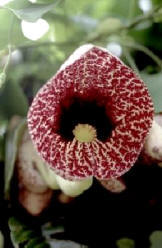|
The
Richmond Birdwing Butterfly
Ornithoptera richmondia
is one
of Australia’s most impressive and beautiful native
butterflies, but unfortunately it is under threat of
extinction. Land clearing changes to horticultural
and agricultural practices, and even the way we
garden has brought about the threat of its demise.
Without food and natural habitat the butterflies
cannot breed.
There
are about 30 species of Birdwing Butterflies that
are native to areas from mainland Asia, Papua New
Guinea, the Solomon Islands and to northeast
Australia where the Richmond Birdwing has its
natural habitat. The male of the species is much
more attractive than the female. The wingspan of the
female is about 14 cm across, while the male is
smaller but much more colourful with dominant
iridescent green wings splashed with velvet black
and a yellow body.
All butterflies are an
important part of the ecosystem, but the Richmond
Birdwing Butterfly is especially important because
it shows us the changes that are occurring in our
environment, in the bush as well as urban areas. It
is a butterfly that was once very common in the
Brisbane area, with thousands occurring in the
streets of Brisbane in the 1870’s, but these have
disappeared in recent years. They have lost their
breeding habitat as well as having only one food
plant for the caterpillars, and these are being lost
along with the bushland. Their habitat used to occur
from Maryborough in Queensland down to the Clarence
River in New South Wales, but there are only small
pockets of the original distribution left outside
Brisbane.

|
OF
DANGER TO THE RICHMOND
BIRDWING
BUTTERFLY
DUTCHMAN'S
PIPE VINE
Aristolochia elegans

(Photo credit: Dr Don Sands)
Dutchman's
Pipe is a distant relative of the
Richmond Birdwing butterfly's native
larval food plant. It emits a substance
that tricks the female butterflies into
laying their eggs on this vine. It was a
very popular introduced vine, planted in
gardens. It is now a bushland weed.
Dutchman’s pipe vine is a vigorous
exotic vine that originates from Brazil
in South America. This vine typically
grows in protected situations with high
humidity, in full to medium light. It
has been (and still is) cultivated as an
ornamental plant in suburban gardens but
has turned ‘garden escapee’ and over
time has spread into bushland, including
local rainforest remnants
Dutchman’s pipe vine is also
known to be
fatally attractive to the Richmond
Birdwing Butterfly
Ornithoptera richmondia; a
large and spectacular butterfly once
common in the Brisbane region.
Unfortunately, female butterflies find
the foliage of Dutchman’s pipe vine
extremely attractive as a food plant for
their larvae. Richmond Birdwings are
known to lay their eggs on the foliage
of Dutchman’s pipe.
The result is that the emerging hungry
larvae are quickly poisoned by the
toxins in the leaves of Dutchman’s pipe
vine,
thus restricting successful
re-establishment and expansion of viable
Richmond Birdwing populations.
Dutchman’s pipe vine is
recognised by its broad, heart-shaped
leaf with a distinct curved leaf base.
Leaves are arranged alternately along
the climbing stem and can be up to 12 cm
long. The under surface of the leaf is a
distinct pale grey-green with a waxy
lustre. Stems of young vines are
slightly channelled and corky, whilst
larger vines are covered with a fissured
corky or spongy brown bark that can be
easily rubbed off
Another distinctive identification
feature of this vine is the fruit - a
segmented papery capsule (up to 6cm
long) which opens like an upside down
parachute and can remain attached to the
vine stem for some time after opening.
Each capsule contains around 350 papery,
tear shaped seeds which are spread by
wind or water (when growing along
creeks).
McDonald, G.J., (1998)
Growing a butterfly garden in
South east Queensland.
Bower, S., (1998) Weed Sheet
No. 10
What’s eating your remnant?
Dutchmans pipe in Big Scrub
Rainforest Landcare Group Newsletter
March 1998
|
At
Beerwah just outside Brisbane,
some gardeners have created
a fabulous natural habitat for the Richmond Birdwing
Butterfly
They have planted hundreds of the Birdwing Vine to
provide a food
source especially for the larvae of the butterfly.
They have also planted
many nectar-producing flowers for the butterflies
themselves.
Not only are they growing these plants themselves
but also they have
involved their neighbours and the whole community to
do the same.
Now that they can observe the butterfly in their own
gardens at close
range, they can see the value of keeping this
beautiful butterfly alive.
For more information - Visit the
following website:
http://www.abc.net.au/gardening/stories/s938771.htm

|
The origin of the word butterfly
comes from the Anglo-
Saxons
which used the word 'butterfloege'
because
their most common one
was the yellow brimstone
butterfly. This English
influence was brought to the new
world.
In
other languages the butterfly's
name means 'licker of
milk'
and milk thief.
In
Russia they're called 'babochka'
or 'little soul'.
The ancient Greeks called
butterflies 'Psyche'
which also means 'soul.'
In
France they are called 'papillon.'
Parking tickets
are called 'papillon'
too, because they are big pieces
of
yellow paper. When they
are placed under a windshield
wiper they flap like a big
yellow butterfly.
The Sioux Indians called
butterflies fluttering wings.
For further interesting Butterfly
information visit
the following website
http://www.gardening123.com/articles/
|
|
